Methinks that is SIMPLY AMAZING, for $139!! Too bad they now are copying the Ibanez instead of a Gibson, but it's still an incredible bargain---I don't know how they do it!!The 335 is probably my favourite guitar design. Ted McCarty's master-stroke! 🙂 You can buy an already-built "335-style" guitar for about the same price, or even for much, much less, in some cases: YouTube )
-Gnobuddy
He... ..has... ...his... ...dad... ...with... ...him.
It is not like he is on his own, doing a complicated build, as said, people with no experience have done it. There is more help in the Shockbrother's forum than you can shake a stick at. Not a lot of parts, post pictures and the guys will walk you through it. With a light bulb limiter and meter they can get you through anything a 5F1 can throw at you. Not a lot of parts, need transformers with the kit.
5F1 Kits
It is not like he is on his own, doing a complicated build, as said, people with no experience have done it. There is more help in the Shockbrother's forum than you can shake a stick at. Not a lot of parts, post pictures and the guys will walk you through it. With a light bulb limiter and meter they can get you through anything a 5F1 can throw at you. Not a lot of parts, need transformers with the kit.
5F1 Kits
I haven't built one myself, but if I were to try it, this kit would be the one I'd try:
335-Style Electric Guitar Kit | stewmac.com
You had to show me this, with that $150 discount.......Guess I'll be building a 335.
I don't think the OP has actually really spelled out what he wants and what roadblocks are there other than price.
If the price of the cab and speaker that go with a kit is a roadblock, then just buy a used 15W solid state amp and gut the electronics.
If having to figure out schematic and layout diagrams is the roadblock, look for guitar amp PCBs. There are a few out there for sale if you Google. A Champ is so simple you could probably just build it on a hifi PCB from ebay by substituting components, but that might overwhelm a neophyte.
If the price of the cab and speaker that go with a kit is a roadblock, then just buy a used 15W solid state amp and gut the electronics.
If having to figure out schematic and layout diagrams is the roadblock, look for guitar amp PCBs. There are a few out there for sale if you Google. A Champ is so simple you could probably just build it on a hifi PCB from ebay by substituting components, but that might overwhelm a neophyte.
That's a quite good suggestion! Then you could buy these 5F1 parts for ~$312:If the price of the cab and speaker that go with a kit is a roadblock, then just buy a used 15W solid state amp and gut the electronics.
https://hoffmanamps.com/MyStore/per...r&thispage=Amp_5F1Parts.htm&ORDER_ID=!ORDERID!
and put them in that gutted cabinet.
I'm building a 5f1 right now.
Simple design, lots of mods possible, proven to sound good, great pedal amp, cheap.
Simple design, lots of mods possible, proven to sound good, great pedal amp, cheap.
First off, how old are you? I assumed you are in your teens, you write coherent sentences and seem to sound like you put some thought in this. I also assumed dad would spend the time with you on this and keep you safe. Otherwise a low voltage kit like a boost pedal would be a place to start.
The thing is, those little 10 and 15 watt amps tend to come with incurably bad sound, because the tiny open-back cabs have nasty acoustic resonances in the frequency band that screams "boxy!" to human ears. Add in the cheap and nasty speaker, and even proper firebottle Champ electronics won't cure the bad sound. In my experience, there is no cure for an awful-sounding cab.If the price of the cab and speaker that go with a kit is a roadblock, then just buy a used 15W solid state amp and gut the electronics.
I've used gutted solid-state cabs for tube conversions before, but always from a larger donor amp. The last donor amp I used was a "Fender Princeton 65 DSP", a horrific sounding solid-state monstrosity that has nothing to do with classic Princetons or the year 1965. It did, however, come with a 12" speaker, and a cab big enough to not suffer from really bad acoustic problems.
All the recently discussed options on this thread cost at least twice, and maybe three or four times, as much as the Monoprice Champ. Personally, I can't see the attraction of a $400 Champ over a $100 Champ.
I would get the $100 Champ, and spend the other $300 on doing something fun with Dad instead. Heck, get the $200 Monoprice 15-watter, which is a very capable amp (see video review linked at the end of post #8), and spend the remaining $200 doing something memorable with Dad.
-Gnobuddy
....shipping 😡 Ok, $200 on shipping to hereabouts. But still!😡I would get the $100 Champ, and spend the other $300 on
I sympathize. Not far from where I live now, a two inch wide stripe of white paint separates Canada and the USA. Many consumer products - guitar amps included - double in cost when they travel those two inches. It's hilarious, when you stand aside and look at how ridiculous that is. 😀....shipping 😡
Of course there are also other major changes to the quality of life that occur when you cross those two inches of white paint. Me, I'm much happier on this side. Overpriced guitar amps are a pretty minor piece of the big picture.
Back to your situation, on the plus side, we all know you have the chops to design and build your own cut-price Champ-alike using whatever valves are cheapest in your corner of the world, along with an Altronics 100 V audio line transformer, a cheap mains isolation transformer, a few surplus camera-flash capacitors, and a thrift-store baking pan. 🙂
Now that I have access to a small wood-shop, I've been able to make my own cabs from the cheapest wood - some twenty or thirty bucks worth of knotty pine. "Proper" grille-cloth can be expensive, so I just go to Marshall's (arts & crafts store), where there is usually left-over open-weave decorative fabric selling for very little.
The only remaining big-budget item is a "proper" guitar speaker. I've made some headway using cheap 8" paging / public address "full range" speakers as a reasonable substitute, at least for home use, but I'm not quite there yet.
-Gnobuddy
Thanks, let me know how it turns out. How much are you building yours for? It's about $600-700 to get a kit where I am.
Sounds about right. I haven't added it up yet but mine will be in that range, maybe a little more since I will be using a 10" speaker. I'll post a video of the design process and build on Youtube when I'm done.
John
Like this? 😀Back to your situation, on the plus side, we all know you have the chops to design and build your own cut-price Champ-alike using whatever valves are cheapest in your corner of the world, along with an Altronics 100 V audio line transformer, a cheap mains isolation transformer, a few surplus camera-flash capacitors, and a thrift-store baking pan. 🙂

I found some even cheaper wood (an old desk) but it's not working out cheaper (as I had to cut 45 mitres and I'm out by about a degree 😱 😱)Now that I have access to a small wood-shop, I've been able to make my own cabs from the cheapest wood
Last edited:
I made the amp in the picture above for the Hundred Buck Amp Challenge. During that adventure there was some heated debate about what constitutes a "tube amp." The loudest objector in the bunch stated that there should not be ANY silicon in the signal path even though this was agreed to in the rules before the challenge started.
Therefore, the amp sitting on my hand has diodes for the rectifier, and no other active parts except tubes. It worked, but just didn't SCREAM, so it wound up in a box and, that box got stuffed in a warehouse during the time period where my career ended, a 1200 mile move ensued, and "retirement" started.
Several years later I found the amp, and fired it up.....BORING, so I ripped it apart. I reinvented the circuit with flying parts. The result is in the first picture. Now it works great, makes more power, 3 watts clean, over 4 cranked, but doesn't quite fit back in the box.....So
I made a new PC board and made a new amp with nice parts and a Hammond chassis. Pictures....
It still looks like that today....never did stuff it back in the box. It can be seen here sitting on top of a DIY speaker cabinet above the third fret.
A little over a year ago there was a dispute about my actual B+ voltage, so I wired a meter from OPT CT to ground which displayed almost 170 volts at idle, and 165.4 volts when doing a trainwreck style feedback with all knobs dimed. Pictures of meter, and the $16 power transformer that couldn't possibly produce 165 volts loaded.
Schematic included.
Therefore, the amp sitting on my hand has diodes for the rectifier, and no other active parts except tubes. It worked, but just didn't SCREAM, so it wound up in a box and, that box got stuffed in a warehouse during the time period where my career ended, a 1200 mile move ensued, and "retirement" started.
Several years later I found the amp, and fired it up.....BORING, so I ripped it apart. I reinvented the circuit with flying parts. The result is in the first picture. Now it works great, makes more power, 3 watts clean, over 4 cranked, but doesn't quite fit back in the box.....So
I made a new PC board and made a new amp with nice parts and a Hammond chassis. Pictures....
It still looks like that today....never did stuff it back in the box. It can be seen here sitting on top of a DIY speaker cabinet above the third fret.
A little over a year ago there was a dispute about my actual B+ voltage, so I wired a meter from OPT CT to ground which displayed almost 170 volts at idle, and 165.4 volts when doing a trainwreck style feedback with all knobs dimed. Pictures of meter, and the $16 power transformer that couldn't possibly produce 165 volts loaded.
Schematic included.
Attachments
-
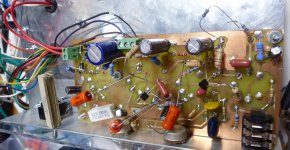 AmpFurball_x.jpg707.3 KB · Views: 146
AmpFurball_x.jpg707.3 KB · Views: 146 -
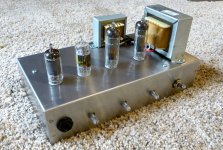 Chassis_1_x.jpg601 KB · Views: 132
Chassis_1_x.jpg601 KB · Views: 132 -
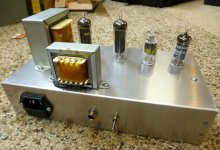 Chassis_3_x.jpg520.5 KB · Views: 127
Chassis_3_x.jpg520.5 KB · Views: 127 -
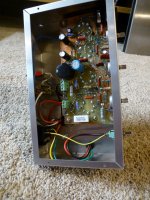 Chassis_4_x.jpg387.8 KB · Views: 112
Chassis_4_x.jpg387.8 KB · Views: 112 -
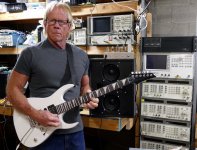 NewGuitar_x.jpg862.3 KB · Views: 113
NewGuitar_x.jpg862.3 KB · Views: 113 -
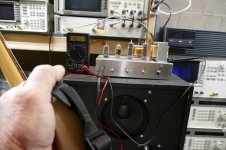 P1000765_x.jpg591.6 KB · Views: 116
P1000765_x.jpg591.6 KB · Views: 116 -
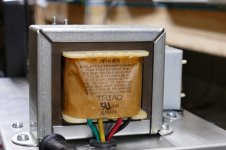 P1000767_x.jpg585.5 KB · Views: 112
P1000767_x.jpg585.5 KB · Views: 112 -
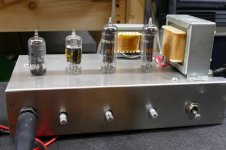 P1000768_x.jpg634.9 KB · Views: 106
P1000768_x.jpg634.9 KB · Views: 106 -
GTA_4T_11-10.pdf22.6 KB · Views: 126
Tubelab_com what are the ohm values of the 3 pots and what are the part numbers for Q1 and Q2 in your posted schematic?
Last edited:
The pots are all 1 MEG and the mosfets are LND150N3's. The LND150N3's are rather scarce right now. The mosfets should be a depletion mode device, so that rules out most common mosfets. A DN2535N3 or DN2540N3 should work too.
It is a pentode with a "gyrator" load whose impedance is determined by the pot. At full crank the pentode is working into a plate load impedance higher than 1 meg. This gives SLO-100 kind of gain in a single stage. A multigrid tube will become highly microphonic at these gain settings so a combo amp is out of the question and setting the head on top of the speaker isn't a good idea either. Someone suggested putting the triode stage before the pentode which might be a good idea but I have not tried it. I have been using this amp as is for about 3 years now with no issues, so I'm hesitant to mess with it.
For those into a more traditional power supply the 18FW6 is just an 18 volt 6AU6, the 18FY6 is an 18 volt 6AV6 and the output tubes could be any 6 volt pentode. A pair of 6V6GT's would make for a good bluesy sound while a pair of EL84's would rock. I would prefer a pair of 6W6's for maximum crank!
For those into a more traditional power supply the 18FW6 is just an 18 volt 6AU6, the 18FY6 is an 18 volt 6AV6 and the output tubes could be any 6 volt pentode. A pair of 6V6GT's would make for a good bluesy sound while a pair of EL84's would rock. I would prefer a pair of 6W6's for maximum crank!
- Home
- Live Sound
- Instruments and Amps
- Looking to build a small Guitar Amp